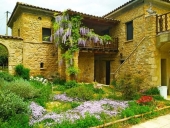posted 17 years ago
Choosing land takes luck, luck, luck and foresight. Two people stake claims on two pieces of land along either side of a winding river in the Yukon. One homestead thrives, the soil remains rich, the crops grow, the water is potable year 'round and the climate, while extreme, seems bearable to the owner. Across the river and upstream the other homestead withers. The soil is thin, the crops won't grow and are stunted, the water is brackish and the land owner suffers greatly from the elements. The grace of God on one homestead? A desecrated burial ground underneath the other? The one difference between the two homesteads was location – and luck of the draw. The blessed homestead lay in the lee curve of the river. Protected by the heavily wooded river bend from the ripping winds that ran down the wind tunnel of the river, and lying in the weather shadow of a distant mountain that blocked heavy snows, the clearing worked with the land, the river, the mountainous terrain and the weather to maximized sunlight, minimize heavy weather and moderate river tides and rain to provide thick fertile soil. Upriver the other homestead remained completely exposed year around to the harshest elements and the soil was lifted off the land and deposited in the river almost daily so that both the land and the water were less than desirable. In a region like the Yukon, that sort of luck can mean the difference between life and death over the homesteader's first winter.
That is how easy it is to fail to pick the right piece of land to homestead. So, what to look for, no matter where you might be considering staking a claim...
Water. Is there a reliable source of water? Can you develop it enough to rely on it, meaning can you sink a well or are you too remote to get heavy equipment into the back country? Will the river or creek or stream freeze in the winter? Will the spring remain viable? If you are going to be reliant on animals will the water source provide enough water for daily household use and animal consumption? If the river freezes is it deep enough to provide bottom water during the winter months?
Elements. Is the land protected from weather extremes? Weather extremes are wind, rain, hail and snow. These kill crops and burn energy, both on the homestead in keeping warm and in the humans or animals with energy expenditure needed to maintain day-to-day operations. On the other hand, rain is needed for crops and sunlight must be maximized. The weather shadow of the mountain previously mentioned can work the opposite way – blocking vital rain, shading a home reliant on sunlight to power and heat it and casting a summer shadow over cropland or gardens. Throwing up a tent and living awhile before claiming is ideal, but it takes about a year to realize everything nature will throw onto your piece of property. Trying to notice the terrain and the give and take of the land, knowing the regional weather and the local lore all helps.
Seasons. Arid land claim in Nevada or Arizona? Will your water source outlast the mid-summer heat? Will the wind leave any soil behind? Will the once yearly rain hit the mountains before it reaches you and leave you parched or blow over you and fall ten miles further on? Wilderness claim in Alaska? Can you get your land parcel functional enough during a very short summer to survive the first very long winter? Can you anticipate the freezes – too early or too late? Research helps a little but trial and error ends up being the determining factor.
Trying to find a parcel of land that utilizes the whole region to its advantage before you develop it increases the likelihood of a successful developed homestead. Observation, research, interviews of locals (if there are any) and the aforementioned blind luck will help...








